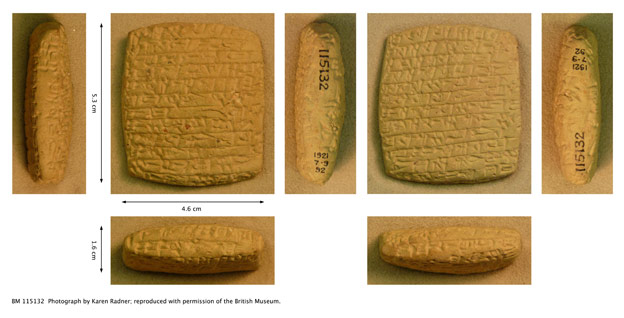BM 115132: letter from Ištar-pilah to Pušu-ken

BM 115132: letter from Ištar-pilah to Pušu-ken (Old Assyrian period, c.1900 BC). Photograph by Karen Radner; reproduced with permission of the British Museum. View large image.
This letter was excavated at the settlement mound of Kültepe near the Great Salt Lake in Central Turkey, in the Assyrian trading colony attached to the city of Kaneš. It is one of about 20,000 cuneiform tablets found there that document the activities of merchants from Assur PGP (modern Qala'at Sherqat) in what is today northern Iraq, situated on the river Tigris halfway between the modern cities of Mosul and Tikrit. With an average one-way journey taking six weeks, the Assyrians needed to maintain a permanent presence at Kaneš, the centre of their Anatolian trade network. Most of the documents found in Kaneš are letters with which business partners and family members communicated with each other long-distance. These letters were delivered by the Assyrian donkey caravans that transported the merchandise between Assur and Anatolia: wool textiles and tin to Anatolia, silver and gold back to Assur.
This letter stems from the archive of Pušu-ken, head of one of the most important trading houses. Another Assyrian trader, Ištar-pilah, writes to Pušu-ken, asking him for help by invoking their good relations ('You are my brother!'). Pušu-ken emerges from the available sources as a canny businessman, not at all adverse to using illegal methods if it made him a profit. Ištar-pilah wants him to help him smuggle merchandise into Kaneš without paying the taxes normally due to the local ruler.
The tablet would have been enclosed in an envelope, a thin layer of clay impressed with the seal of the sender and bearing his name and that of the recipient. Upon receiving the letter, the recipient would have cracked open the envelope in order to read the inner tablet; as a consequence, the envelopes survive only if a letter never reached its intended recipient.
Old Assyrian cuneiform uses only about a hundred signs of a relatively simple shape and, apart from some handy logograms for very common nouns such as "silver" or "donkey", is written syllabically. Note also the line rulings which are typical for this period: rather than sitting on the line, the cuneiform signs "hang" from it, like laundry on a washing line. Because of the comparatively undemanding nature of the writing system and also because many of the letters were written on the go, we assume that the majority of them were written by the correspondents rather than by professional scribes: the level of literacy among the traders and their families was certainly high.
For a scale drawing of this text, view the record for this tablet on the British Museum's research database [http://www.britishmuseum.org/research/search_the_collection_database.aspx].
A French translation of this text can be found in Michel, Correspondance (2001), no. 160 (= CCT 4, 11a).
Content last modified on 10 Jan 2017.
Karen Radner
Karen Radner, 'BM 115132: letter from Ištar-pilah to Pušu-ken', Knowledge and Power, Higher Education Academy, 2017 [http://oracc.museum.upenn.edu/saao/knpp/cuneiformrevealed/tabletgallery/bm115132/]